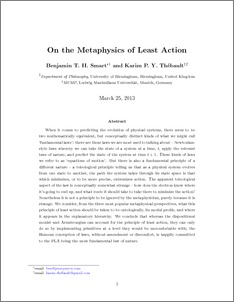Thebault, Karim P Y and Smart, Benjamin T H
(2013)
On the Metaphysics of Least Action.
[Preprint]
![[img]](https://philsci-archive.pitt.edu/style/images/fileicons/application_pdf.png)  Preview |
|
PDF
On_The_Metaphysics_of_Least_Action_Archive.pdf
- Draft Version
Download (347kB)
|
Abstract
When it comes to predicting the evolution of physical systems, there seem to be two mathematically equivalent, but conceptually distinct kinds of what we might call `fundamental laws': there are those laws we are most used to talking about -- Newtonian-style laws whereby we can take the state of a system at a time, $t$, apply the relevant laws of nature, and predict the state of the system at time $t+1$. These kinds of laws we refer to as `equations of motion'. But there is also a fundamental principle of a different nature -- a teleological principle telling us that as a physical system evolves from one state to another, the path the system takes through its state space is that which minimizes, or to be more precise, extremizes action. The apparent teleological aspect of the law is conceptually somewhat strange -- how does the electron know where it's going to end up, and what route it should take to take there to minimize the action? Nonetheless it is not a principle to be ignored by the metaphysician, purely because it is strange. We consider, from the three most popular metaphysical perspectives, what this principle of least action should be taken to be ontologically, its modal profile, and where it appears in the explanatory hierarchy. We conclude that whereas the dispositional monist and Armstrongian can account for the principle of least action, they can only do so by implementing primitives at a level they would be uncomfortable with; the Humean conception of laws, without amendment or discomfort, is happily committed to the PLA being the most fundamental law of nature.
Monthly Views for the past 3 years
Monthly Downloads for the past 3 years
Plum Analytics
Actions (login required)
 |
View Item |



